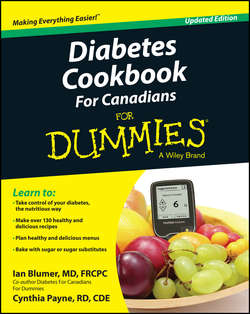Читать книгу Diabetes Cookbook For Canadians For Dummies - Cynthia Payne - Страница 6
На сайте Литреса книга снята с продажи.
Part I
Getting Started with Diabetes & Cooking
Chapter 1
Diabetes 101: Discovering the Basics
Investigating How Diabetes Is Diagnosed
ОглавлениеDiabetes – in any form – is a serious disease and, befitting this, is diagnosed according to strict criteria. According to the Canadian Diabetes Association’s criteria, you have diabetes if you have any one of the following:
✔ A random blood glucose level equal to or greater than 11.1 millimoles per litre (mmol/L). Random is defined as any time of day or night, without regard to how long it’s been since the last time you ingested anything containing calories.
✔ A fasting blood glucose level equal to or greater than 7.0mmol/L. Fasting is defined as eight or more hours without calorie intake.
✔ A blood glucose level equal to or greater than 11.1mmol/L, when tested two hours after ingesting 75 grams of glucose as part of what is called a glucose tolerance test.
✔ An A1C level equal to or greater than 6.5 percent. The A1C is measured on a blood test and allows for an estimate of one’s average blood glucose level for the preceding three months. The A1C should not be used as a diagnostic test for diabetes if you are a child, an adolescent, are pregnant, if type 1 diabetes is suspected, or if you have a condition which can affect its accuracy.
Testing positive for one of the preceding criteria on a single occasion is not enough to make a diagnosis of diabetes (although important exceptions exist, which we discuss next). Any one of the tests must be also be positive on another day to establish the diagnosis. Also, the diagnosis of diabetes should be based on a blood sample taken from a vein and analyzed at a laboratory; the diagnosis should not be made based on a blood glucose level measured with a blood glucose meter.
Waiting for another day to have a second test performed after having an initial high blood glucose discovered is not required – and indeed, can be dangerous in two circumstances:
✔ If your initial blood glucose level is 11.1mmol/L or higher and you have symptoms of high blood glucose (frequent urination, increased thirst, loss of weight)
✔ If your doctor thinks you may have type 1 diabetes (especially if you are a child)
In either of these circumstances, the diagnosis of diabetes is made without a second test, and you need to start treatment immediately.
